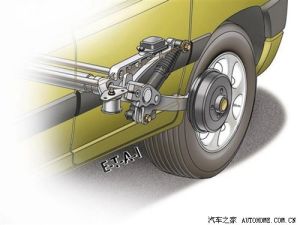1, three vehicle running characteristic curve
steering characteristic generally be divided into understeer, neutral steer, and oversteer three cases.
 understeer
understeer
① steering performance of the vehicle is less than the actual steering angle of the bend is smaller than the rotational angle of the front wheels, i.e. the front wheel appeared to the outside slide this turn also commonly known as “pushing head.”
 oversteer
oversteer
② oversteering vehicle performance in the actual steering angle is greater than the bending angle of rotation of the front wheels, i.e. the rear appeared slide to the outside.
③ neutral steering performance of the vehicle in the actual steering angle of the bending angle of rotation of the front wheels exactly, such a steering characteristic often maximum turning speed, but it also reduces the vehicle driver close to the physical limits of subjective feelings to some extent.
For the first drive, in the event of an understeer, it can be solved by reducing the speed. But if more serious over-steering the direction and with the need to fight anti-fuel to pass, which is the drift of skill, but it is very high demand for motorist. So, in general, ordinary civilian cars on tuning the steering characteristics will be biased in favor of a slight understeer in order to ensure driving stability.
2, the rear wheel steering effect on the vehicle steering characteristics
and the presence of the front wheels with the steering wheel and reverse two cases, and both cases will It showed two completely different steering characteristics. It is simply to increase with understeer, oversteer reverse the increase. Vehicle at low speeds, the rear wheel by reverse rotation of the front wheel to appropriately increase the oversteer. High-speed running vehicle when the situation encountered in the emergency lane, without the aid of any electronic assistant system, it is easy to oversteer tendency, the rear wheel is generated by a small but significant shift in the same direction of the front wheels you can compensate for oversteer tendency, which would allow the car a better balance.
the vehicle is cornering, the vehicle wheel ground contact area, andWheel positioning changes will lead to changes in the steering characteristics. It should be said rear wheel steering vehicle technology can make the use of birth defects in a pneumatic tire rubber caused by the steering mechanism. This works like a steering wheel ESP system, i.e., when the vehicle moves at high speed through the braking one or several wheels, in order to maintain a stable posture of the vehicle is traveling.
 2
2
At present, the rear wheel steering is achieved in two ways, one is achieved by a mechanical structure, the other is It is achieved by a motor or hydraulic. Rear-wheel steering is achieved by mechanical structures tend to be passive, generally rely on vehicle lateral friction surface of the rear wheels during cornering to generate a slight turn, here we take a look at PSA Peugeot Citroen’s rear-wheel steering technology .
3, rear-wheel steering
 3
3
This structure is very simple, it is not disposed in the rear wheel steering mechanism of a complete, but only in the rear wheel suspension, the suspension is disposed between the vehicle body and some rubber cushion, and allow the suspension to the vehicle body by rubber to achieve a flexible connection, since there is a certain rubber elasticity, when the car turns, rear suspension connecting point of the rubber cushion can occur to a certain extent under the action of a transverse force an elastic deformation so as to drive the wheel to make a certain angle changes. The steering angle depends on the hardness of the rubber pad. The softer the rubber, the greater the steering wheel angle variable, but to reduce the differential stiffness of the suspension stability, the harder the rubber cushion, the rear wheel steering angle is smaller, but the suspension stiffness, high stability. Hence tradeoffs in the design of their advantages and disadvantages, according to the focus adjustment to make the actual use of an automobile, in general, in the rear wheel steering angle 3 degrees.
While this is a passive steering mechanism, but its structure is relatively simple, low-tech, low cost. So it can be applied in a number of economy cars such as Citroen models and so on.
4,Rear-wheel active steering
For a large luxury car, the car’s wheelbase is longer continue to bring good comfortable ride space, but it also brings to the vehicle’s handling of certain negative effects . Whether turning radius at low speeds or when driving high speed stability will be compromised. By the addition of rear-wheel steering system can compensate for the vehicle driving characteristics caused by the increase in wheelbase, while allowing a luxury car also has a good driving pleasure. This principle active rear steering system is not complex, is a set screw nut mechanism, the screw drive motor to generate a drive nut to move axially. This axial movement will lead to a slight steering rear wheels when the vehicle speed is 60km / h or more, the front wheels with the rear wheels deflected improve the stability of the high-speed cornering. When 60km / h or less the reverse deflection, increase the flexibility of the vehicle.
This active rear steering system of the technological content mainly concentrated in the control system work, it needs to accept various vehicle dynamic driving signal, and then outputs a comprehensive judgment with appropriate steering angle, any calculated mistakes are likely to result in loss of vehicle control, particularly when high-speed driving.